Kristine Hughes's Blog, page 77
April 17, 2015
LOOSE IN LONDON: A DAY AT OSTERLEY PARK
 Osterley Park
Osterley ParkVictoria, here, reporting on the day Kristine and I spent at this jewel in Robert Adam's architectural crown. Osterley Park is managed by the National Trust and a very good job they do! I had visited the estate several years ago, and this time I was excited to learn that we could take pictures INSIDE. So, prepare yourselves for a set of interior shots of many rooms. All pictures in this post were tken by me or Kristine, unless otherwise noted.
 We could not stop snapping!
We could not stop snapping! Kristine leans in for a close-up
Kristine leans in for a close-upBut I am getting ahead of myself! The approach to the house is suitably dramatic, viewed across a pond laced with water lilies in full bloom. Queen Elizabeth I visited the first manor house here after its completion in 1676. Thomas Gresham, a wealthy banker, built the house, Another wealthy banker, Sir Francis Child, hired Robert Adam to remodel it in 1761, and the current look - both inside and out - is very much that of the Adam period in all its glory. Adam had one section of the square house replaced with handsome Georgian columns, framing an open courtyard. The great house and estate passed down in the line of the Child banking family. Sarah Sophia Fane inherited the house from her grandfather, Robert Child; she married George Villiers (who added Child to his surname) who became the 5th Earl of Jersey. Thus the house for almost 200 years, belonged to the Earls of Jersey. The 9th earl presented it to the National Trust in the 1940's.
 The Approach
The Approach Blooms in the Pond
Blooms in the Pond Entering....
Entering.... The Courtyard
The CourtyardBefore we go any farther, we've written on this blog about Osterley before.
Click here to read about my previous visit and the history of the house.
Read here about The Two Lady Jerseys.
Click here for the obituary of Lady Jersey, Almack's patroness, in a Gentleman's magazine of 1867.
We arrived in time for a curator's tour, but we had time to take a quick look around before it began.
 The Entrance Hall
The Entrance HallThe Entrance hall has identical alcoves at each end with a fireplace and two classical statues in each.
 Entrance Hall
Entrance HallThis room was used as a saloon and reception room and occasionally for dining; Adam designed it to replace the original hall demolished for the columned entrance. The colors are subtle and effective in pleasing the eye with their near-monochromatic, soothing effect.
 The floor of black marble on white reflects the design in the ceiling, a frequent Adam feature.
The floor of black marble on white reflects the design in the ceiling, a frequent Adam feature.

 Wall designs are classical and yet light, in the rococo manner.
Wall designs are classical and yet light, in the rococo manner. The Eating Room
The Eating RoomThe large painting between the doors is by Antonio Zucchi (1726-1795) entitled Figures Sporting in a ruined Roman Bath, part of a set of paintings he did, including The Four Continents, above the doors. Twelve mahogany chairs with lyre backs and two arm chairs were designed by Robert Adam and probably made by John Linnell (1729-1796) of London; Linnell executed the designs for the rest of the room's furnishings as well. The chairs are placed around the perimeter of the room in the 18th C. manner. Tables of several sizes were kept in the servant's passages; they could be set up when needed.
 The Eating Room
The Eating RoomThe NT guidebook quotes Agneta Yorke commenting on the sideboard "'magnificently furnished with plate, and under the Table was a Massy and large silver Cistern', reminding them of the fact that the Childs were goldsmith bankers and extremely rich." The painting, in this slightly blurry picture, is another of Zucchi's capricci of 1767, Turkish figures dancing among classical ruins.
 Pier table topped with antique marble mosaics, one of a pairboth topped by ornate 7-foot tall mirrors
Pier table topped with antique marble mosaics, one of a pairboth topped by ornate 7-foot tall mirrors Marble Fireplace, with Doric columnsPainting by Giovanni Battista Cipriani (1727-85) An offering to Ceres
Marble Fireplace, with Doric columnsPainting by Giovanni Battista Cipriani (1727-85) An offering to Ceres
A small group gathered in the Gallery to hear the curators speak about the house, its design and its treasures, its history and the continuing restorations of various rooms both above and below stairs to their appearance when completed by Adam. We found some places to sit, but not, of course, on any of the antique furniture.
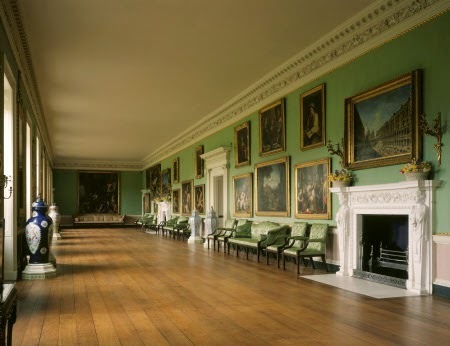 The Gallery photo ©National Trust
The Gallery photo ©National Trust
The gallery is 130 feet long and faces the garden. It once housed a billiard table and a fortepiano. Henry James described the room as 'a cheerful upholstered avenue into another century.'
 A gilt girandole, one of six in the Gallery
A gilt girandole, one of six in the GalleryAbove is one of six mirrored girandoles (ornamental branched candlesticks), also made by John Linnell for Robert Adam.
 Two pairs of Chinese mandarin jars date from the reign of the Chinese emperor Qianlong (1736-95)
Two pairs of Chinese mandarin jars date from the reign of the Chinese emperor Qianlong (1736-95) One of several settees, also part of Linnell's suite of furniture made for the gallery; the matching chairs can be seen below.
One of several settees, also part of Linnell's suite of furniture made for the gallery; the matching chairs can be seen below. The Marble Fireplace, one of two by Joseph Wilton.
The Marble Fireplace, one of two by Joseph Wilton.  A copy of the NPG painting of Robert Adam, c. 1770-75; attributed to George Willison
A copy of the NPG painting of Robert Adam, c. 1770-75; attributed to George Willison one of the two beautifully gilded floral candelabra above the fireplace
one of the two beautifully gilded floral candelabra above the fireplace The frieze includes marigolds, the symbols of Childs Bank
The frieze includes marigolds, the symbols of Childs Bank The model Chinese Junk is made of Ivory and bone, and comes from Guangzhou, c. 1750
The model Chinese Junk is made of Ivory and bone, and comes from Guangzhou, c. 1750 The porcelain pagoda is if a similiar date.
The porcelain pagoda is if a similiar date.At the conclusion of the curator's talk, we explored the rest of the house, and what an exploration it was. Our pictures can only give a hint of what it was like, an abundance of magnificent paintings, furniture, rugs...all dazzling to us poor mortals.
 Adam's touch at the doorway of the Drawing room
Adam's touch at the doorway of the Drawing room Ceiling design in the Drawing Room
Ceiling design in the Drawing RoomAccording to the Guidebook, this ceiling is based on the drawing of the Temple of the Sun in ancient Palmyra, adapted to the rectangular shape of the room.
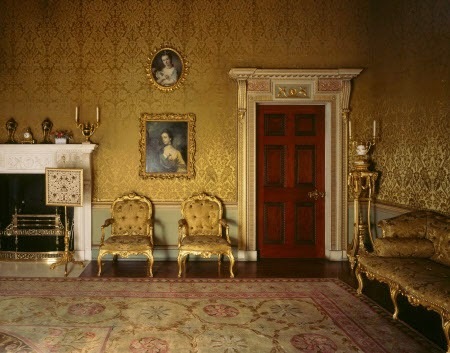 The Drawing Room photo ©National Trust
The Drawing Room photo ©National TrustEven while moving from one magnificent room to another, the next two were jaw-dropping in effect.
Horace Walpole thought this room 'the most superb and beautiful that can be imagined." We agreed.Adam designed the ceiling first.
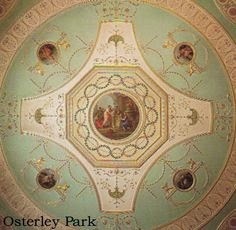 Tapestry Room ceiling photo ©National Trust
Tapestry Room ceiling photo ©National Trust The Tapestry Room
The Tapestry RoomBoucher's Tapestries were delivered to the house in 1776 from the Gobelins factory in Paris, though run by a Scot, Adam's countryman.The four large medallions in the tapestries (two seen above) represent the elements: earth, fire, air, and water.
 The tapestry medallion above the fireplace is Cupid and Psyche.
The tapestry medallion above the fireplace is Cupid and Psyche.The furniture was built by Linnell and upholstered to match the deep rose background of the tapestries. Similiar tapestries in a drawing room designed by Adam can be seen at the Metropolitan Museum of Art in New York City, where the Tapestry Room from Croome Court in Worcestershire now resides. Read more about this room here. This is the ante-room to the State bedroom, which almost overwhelms the visitor. Imagine what it would be like to try to sleep in this bed.
 The State Bed
The State Bed
 Ceiling Medallion by Angelica Kauffman, Aglaia, one of the Three Graces being enslaved by Love
Ceiling Medallion by Angelica Kauffman, Aglaia, one of the Three Graces being enslaved by Love The Fire Board, in the Etruscan style
The Fire Board, in the Etruscan style Black and Gold Japanned Commode, probably ChippendalePier Glass mirror reflecting the State Bed
Black and Gold Japanned Commode, probably ChippendalePier Glass mirror reflecting the State Bed A repository for the necessary, aka chamber pot
A repository for the necessary, aka chamber potThen, to add to the phenomenal variety of decorative motifs, comes the Etruscan Dressing Room, with designs drawn from ancient Etruscan vases discovered in Italy. These designs were eagerly adopted into architectural decor and into popular patterns manufactured by Josiah Wedgwood and others in the mid 18th Century.
 The Etruscan Dressing Room
The Etruscan Dressing Room Ceiling of the Etruscan Dressing Room
Ceiling of the Etruscan Dressing Room Fire Screen designed by Adam and embroidered by Mrs. Child
Fire Screen designed by Adam and embroidered by Mrs. Child View towards the windows, Etruscan Dressing Room
View towards the windows, Etruscan Dressing RoomThe crest of the pier-glass is painted to match the medallions on the walls. The japanned commode is another attributed to Chippendale.
 The Great Stair
The Great StairThe north side of the house is less dramatic that the south side where the State rooms are. The library looks exactly like the kind of place we need for our most capable work. What are the chances?
 The Library
The LibraryThe painting above the mantel is by Antonio Zucchi (1726-95) Virgil reading his works to Augustus and Octavia
 Think of the work you could do at this desk! What a joy.
Think of the work you could do at this desk! What a joy.The last room on the north side, formerly known as the Breakfast Room, was under renovation. We found it fascinating to see a work in progress.



In the room were several beautiful pieces of what appeared to me to be valuable oriental-style furniture. No explanation was given for the state of the room or the random placement of these items. Guess I'll just have to go back and see what happened!!

We have much more to tell you about Osterley -- below stairs, the farm market and the horses. Come back soon!
Published on April 17, 2015 00:30
April 15, 2015
WATERLOO WEDNESDAY: THE COSTUME SOCIETY CELEBRATES WATERLOO
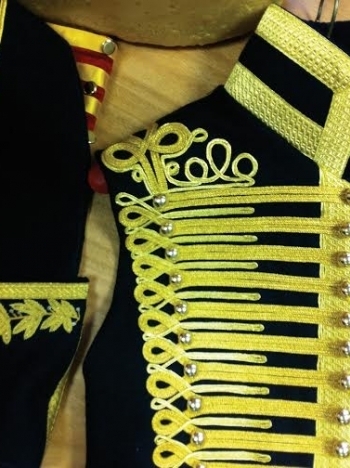
Saturday, May 9th
To celebrate the bicentenary of the Battle of Waterloo, the Costume Society is holding the first of their Jubilee Year Study Days in Bath.
The morning will have Uniformly Splendid: Dress and Death on the field of Waterloo. Nigel Arch, former Director of Kensington Palace and a military dress historian, will be considering the Battle of Waterloo, fought on Sunday 18 June 1815, as the last great encounter between European armies wearing the superb uniforms of the eighteenth century.
Rosemary Harden, Manager of the Fashion Museum, will be discussing A Brilliant Affair: Dress and Fashion at the Waterloo Ball, looking at some of the dresses worn at the Duchess of Richmond’s famous ball held in Brussels on 15 June 1815 just before the Battle of Waterloo. Two of these dresses are now in the collection at Bath.
In the afternoon there will be a ‘dressing’ of two of Bath’s residents in outfits of the period from their linens out.
You are invited (encouraged even) to come in costume - rest assured that you will not be alone! But you might need a bit of time to arrange an outfit.
Some members have agreed to join in with advice and possible hands-on help. If you’d like to help (with or without professional charges), can provide advice or even an outfit, please contact Fiona Starkey: email membership@costumesociety.org.uk who is compiling a list of the willing and the wanting.
And if you really want to push the boat out - the Jane Austen dancers are holding their Waterloo ball in the Assembly Rooms, Bath on the same evening. www.janeaustendancersbath.co.uk for details.
For more information download the poster Waterloo_trailer.pdf
The Study Day is being held at The Old Theatre (Masonic Hall) in Orchard Street, Bath BA1 1JU. Five minutes' walk from Bus and Train stations and worth a visit in its own right.
10.00 Coffee on arrival
10.30 Rosemary Harden on A Brilliant Affair: Dress and Fashion at the Waterloo Ball. Ballgowns in the fashion museum
11.30 Nigel Arch on Dress and Death on the field of Waterloo: military uniforms12.30 lunch break. Buffet available as an option (see booking form)
14.00 The 'Crinoline' group with two 1805 outfits (his and hers) recreated and dressed on stage from shirt out. Based on Janet Arnold patterns.
15.15 tea
16.00 end
Click here for Costume Society Website and Booking Details 1/5CC [image error]
Published on April 15, 2015 00:00
April 13, 2015
GODS AND HEROES: MASTERPIECES FROM THE ÉCOLE DES BEAUX-ARTS, PARIS
 Catalogue of the Exhibition
Catalogue of the ExhibitionVictoria here. The Baker Museum in Naples, FL, is currently hosting the exhibition Gods and Heroes, through May 17, 2015. Organized by the American Federation of Arts (AFA) and the École des Beaux -Arts, Paris. it has been shown previously in Oklahoma City and Albuquerque and will travel to Portland, OR, June 13-September 13, 2015.
 École des Beaux -Arts, Paris.
École des Beaux -Arts, Paris.According to the AFA, "This rich overview of masterpieces from the École des Beaux-Arts—the original school of fine arts in Paris and a repository for work by Europe’s most renowned artists since the fifteenth century—includes approximately 140 paintings, sculptures, and works on paper dating from the seventeenth through nineteenth centuries. The focus is on epic themes such as courage, sacrifice, and death, as well as the ways that changing political and philosophical systems affected the choice and execution of these subjects."
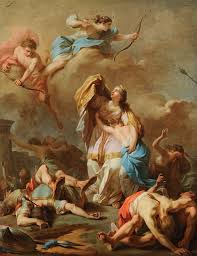 Pierre-Charles Jombert Apollo and Diana Killing the children of Niobe 1772
Pierre-Charles Jombert Apollo and Diana Killing the children of Niobe 1772Describing the exhibition, the AFA writes: "The epic deeds of gods and heroes, enshrined in the Bible and the works of Homer, were the primary narratives from which both aspiring and established academicians drew their inspiration. Their ideology was rooted in the study of the idealized human form as envisioned in classical art. At the École, learning how to construct persuasive and powerful paintings from carefully delineated anatomy, expressive faces, and convincing architectural and landscape settings was understood by aspiring artists to be the route to success and recognition."
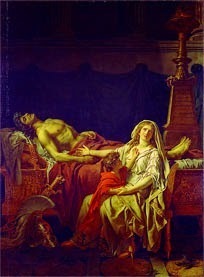 Jacques-Louis David, Andromache Mourning Hector, 1783
Jacques-Louis David, Andromache Mourning Hector, 1783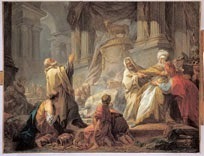 Jean-Honoré Fragonard, Jeroboam Sacrificing to the Idols, 1752
Jean-Honoré Fragonard, Jeroboam Sacrificing to the Idols, 1752You will encounter paintings by David, Fragonard, Ingres and Bouguereau, among many others. Also many prints and drawings used for teaching are included by artists such as da Vinci, Titian, Durer, and Rembrandt.
 Pierre Monier The Conquest of the Golden Fleece 1663
Pierre Monier The Conquest of the Golden Fleece 1663The painting above, based on the Greek stories of Jason, was the first winner of the Grand Prix fro the Ecole in 1663, a reminder of how long the school has been in operation.
 Jean-Auguste-Dominique Ingres, Achilles Receiving the Ambassadors of Agamemnon, 1801
Jean-Auguste-Dominique Ingres, Achilles Receiving the Ambassadors of Agamemnon, 1801 William-Adolphe Bouguereau. Disdain, 1850.
William-Adolphe Bouguereau. Disdain, 1850. Some of the paintings on view were executed for annual competitions on themes chosen by the school, such as expression (see above) or the male torso (see below.) These competitions were watched closely for new approaches and growing expertise.
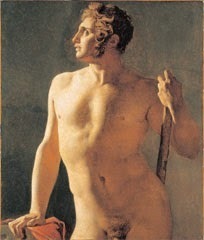 Jean-Auguste-Dominique Ingres, Painted Half Torso 1800
Jean-Auguste-Dominique Ingres, Painted Half Torso 1800Wandering among these paintings, illustrations of teaching techniques and as 'simple' as the two above and elaborate tableaux of assorted gods or heroes on crowded canvases, I could not help thinking of what college professors taught at the time I took art history courses. Speaking of the late 19th century, they told us that the academicians were stuck in the rubble of the past and ignored the new currents being developed by the Impressionists (then a title of derisiion) -- while those staid old-fashioned paintings of the academicians admitted to the official salon were admired, Monet, Renoir and their like were being ignored and had to organize their Salon des Rufusés to show their work. Thus I never really developed an appreciation for the academicians. This show went quite a ways towaards remeding that situation. I found I could enjoy these works for their own sake -- though if I were to chose one to hang on my own walls, I might have had a tough time.
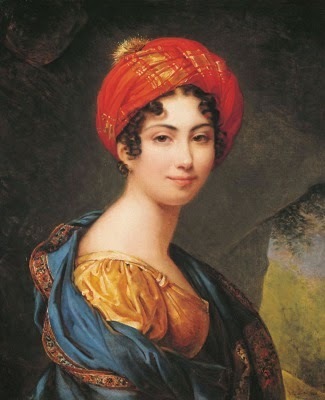 Julie Duvidal Montferrier Self Portrait 1818
Julie Duvidal Montferrier Self Portrait 1818Full name, Louise Rose Julie Duvidal Monferrier (1797-1865) exhibited works at the Salon. She married Abel Hugo, the brother of Victor Hugo. I admire the direct gaze in this self-portrait, and it reminds me of the work of the artist below, who also did many self-portraits, though none of them are in this exhibition.
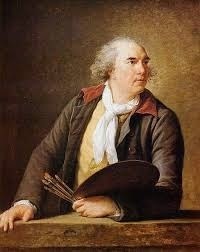 Louise Elisabeth Vigee-Lebrun: Portrait of Hubert Robert, 1788
Louise Elisabeth Vigee-Lebrun: Portrait of Hubert Robert, 1788Robert was a painter who specialized in idealized landscapes for persons such as Madame du Barry. This portrait, said to be among her finest, shows Vigee Lebrun's close rapport and respect for him.
If you have the opportunity to visit this exhibition in Naples or Portland, I hope you will enjoy it as I did. Always time for something old -- becoming something new!
Published on April 13, 2015 00:30
April 10, 2015
LOOSE IN LONDON: STROLLING LONDON
After leaving Sir John Soane's House, Victoria, Marilyn and myself made our way over to Covent Garden - land of flower sellers, ladies of ill repute and some nefarious goings on. And that's just today. Seriously, though, it would have been nice to see some of the old street sellers who once haunted this market. As usual, I found that with a little imagination, there are glimpses of the old market to still be seen today.

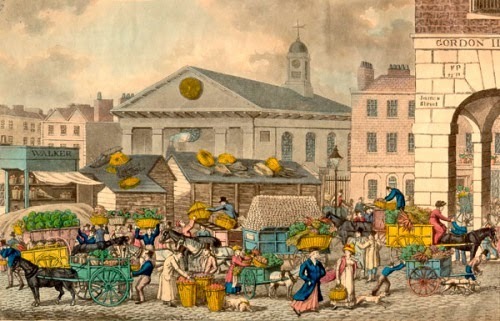
Before we explored any further, we decided that a spot of lunch wouldn't go amiss and we left the Market in search of food.



We soon found ourselves in front of the Marquess of Angelsey pub. Now, this would have been a spot that spoke to Waterloo hearts if Victoria and I hadn't known what was waiting for us just a street away.


The Blue Plaque explains that the offices of Charles Dickens' magazine, All The Year Round, were once located in this building.

And just down at the corner . . . . . our favourite Duke of Wellington pub, not to be confused with the Duke of Wellington pub near our hotel in Kensington where we'd already eaten twice.


It was a glorious day and we opted for an outside table, where we ordered small plates and shared a meal.


Afterwards, we went back to Covent Garden so that Marilyn could see more of it.

Buskers/mimes in front of St. Paul's Church, Covent Garden

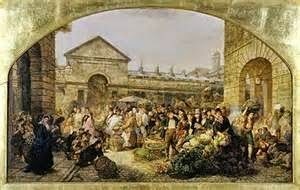
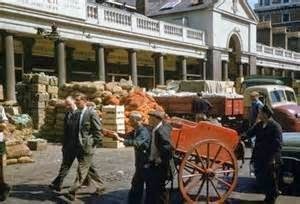

We were lucky enough to be strolling by as an opera singer was belting out Ave Maria.

The flower market now (above) and then (below).
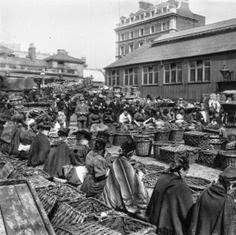


We strolled by the ubiquitous Covent Garden pigeons. Alas, no Audrey Hepburn in sight.

The entrance to St. Paul's Churchyard, now (above) and then (below).
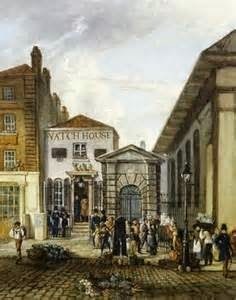


Rear of St. Paul's Church, Covent Garden which opens on a small rose garden that happened to be gloriously in bloom when we visited.






Roses behind St. Paul's Church


Leaving the churchyard, we found ourselves near Bedford Court, where we grabbed a cab and went to my favourite antique dealer in Cecil Court.



To my great delight, they had a Copeland bust of the Duke of Wellington after Comte D'Orsay, 1846.


The Duke and all his acquaintances thought that D'Orsay's work was the best likeness of Wellington. I did, too, and so Reader, I bought it. I was smart enough to ask them to hold on to the bust until my return to London in a week's time.
Being that Victoria and Marilyn were still in a shopping mood, we hoofed it over to Liberty's before meeting up with Diane for dinner at Burger Lobster in Curzon Street. Diane had been meeting with her Mills and Boon editors in Richmond, so she had lots to tell us in between our accounts of a busy day. Here's her website and book info.


After a fabulous meal, Victoria and I took Diana and Marilyn on an impromptu walking tour of Mayfair, which included a stroll past Beau Brummell's house in Chesterfield Street.

The Beau's House, #4 Chestnut Street, sports two blue plaques: one for the Beau (1778-1840), the other for former PM Anthony Eden, Lord Avon (1897-1977), in office 1955-57.

At the top of the street, we turned onto Charles Street, which is chock full of period architectural detail. Here is #22 Charles Street, once the home of HRH Prince William, Duke of Clarence, later King William IV who reigned from 1830-37.
We walked the Regency streets for a while longer, but by this time, we were all fairly tired and so we headed back to the hotel and called it a day. And what a day it had been. Needless to say, the four of us laid our tired heads upon our pillows and looked forward to our next adventure.
More Loose in London coming soon!


Before we explored any further, we decided that a spot of lunch wouldn't go amiss and we left the Market in search of food.



We soon found ourselves in front of the Marquess of Angelsey pub. Now, this would have been a spot that spoke to Waterloo hearts if Victoria and I hadn't known what was waiting for us just a street away.


The Blue Plaque explains that the offices of Charles Dickens' magazine, All The Year Round, were once located in this building.

And just down at the corner . . . . . our favourite Duke of Wellington pub, not to be confused with the Duke of Wellington pub near our hotel in Kensington where we'd already eaten twice.


It was a glorious day and we opted for an outside table, where we ordered small plates and shared a meal.


Afterwards, we went back to Covent Garden so that Marilyn could see more of it.

Buskers/mimes in front of St. Paul's Church, Covent Garden




We were lucky enough to be strolling by as an opera singer was belting out Ave Maria.

The flower market now (above) and then (below).



We strolled by the ubiquitous Covent Garden pigeons. Alas, no Audrey Hepburn in sight.

The entrance to St. Paul's Churchyard, now (above) and then (below).



Rear of St. Paul's Church, Covent Garden which opens on a small rose garden that happened to be gloriously in bloom when we visited.






Roses behind St. Paul's Church


Leaving the churchyard, we found ourselves near Bedford Court, where we grabbed a cab and went to my favourite antique dealer in Cecil Court.



To my great delight, they had a Copeland bust of the Duke of Wellington after Comte D'Orsay, 1846.


The Duke and all his acquaintances thought that D'Orsay's work was the best likeness of Wellington. I did, too, and so Reader, I bought it. I was smart enough to ask them to hold on to the bust until my return to London in a week's time.
Being that Victoria and Marilyn were still in a shopping mood, we hoofed it over to Liberty's before meeting up with Diane for dinner at Burger Lobster in Curzon Street. Diane had been meeting with her Mills and Boon editors in Richmond, so she had lots to tell us in between our accounts of a busy day. Here's her website and book info.


After a fabulous meal, Victoria and I took Diana and Marilyn on an impromptu walking tour of Mayfair, which included a stroll past Beau Brummell's house in Chesterfield Street.

The Beau's House, #4 Chestnut Street, sports two blue plaques: one for the Beau (1778-1840), the other for former PM Anthony Eden, Lord Avon (1897-1977), in office 1955-57.

At the top of the street, we turned onto Charles Street, which is chock full of period architectural detail. Here is #22 Charles Street, once the home of HRH Prince William, Duke of Clarence, later King William IV who reigned from 1830-37.
We walked the Regency streets for a while longer, but by this time, we were all fairly tired and so we headed back to the hotel and called it a day. And what a day it had been. Needless to say, the four of us laid our tired heads upon our pillows and looked forward to our next adventure.
More Loose in London coming soon!
Published on April 10, 2015 00:00
April 8, 2015
WATERLOO WEDNESDAY - WELLINGTON AND THE BATTLE OF WATERLOO - FREE ONLINE COURSE

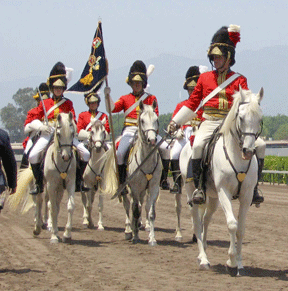
Wellington and the Battle of WaterlooMark the bicentenary of the Battle of Waterloo in 2015 and explore the Duke of Wellington’s archive with this free online course.
About the courseThe Battle of Waterloo was one of the key events of nineteenth-century history, but why was it fought, who was involved and what were consequences? This free online course will answer these questions, marking the 200th anniversary of Waterloo on 18 June 2015.
Forming a coalition to defeat Napoleon
We will explain why Europe had been at war almost continuously since 1793; how a peace settlement in 1814 had followed the abdication of Napoleon as Emperor of the French; and how further negotiations were under way at the Congress of Vienna when Napoleon escaped from Elba in February 1815.
The process of gathering military support and a legal basis for a further campaign against Napoleon will be explored, as well as the ways in which a coalition of Allied Powers assembled an army, led by the Duke of Wellington, to fight the French.
We will examine sources from the Battle of Waterloo itself — from official despatches to the voice of the individual soldier — and consider the ways in which different interpretations arise, before discussing the immediate consequences of the battle and the peace settlement that followed.
The course will conclude by examining the longer-term place of Waterloo and Wellington in commemoration and memory, the arts and popular culture, and the connections that were made to nineteenth-century ideas of heroism, nationality and identity.
Exploring the Duke of Wellington’s archive
We will use the University of Southampton’s Wellington Archive — a collection of over 100,000 items from the Duke’s military and political career — to contextualise the battle and the role of Wellington in commanding the allied forces against Napoleon.
You will learn with Professor Chris Woolgar, Professor of History and Archival Studies, who has an international academic reputation as a Wellington scholar and archivist, and Karen Robson, Head of Archives at the University of Southampton Library.
 FREE online course Duration: 3 weeks 4 hours pw Certificates available
FREE online course Duration: 3 weeks 4 hours pw Certificates available
Educators
Chris Woolgar

Karen Robson
Requirements - This course is aimed at both A-level students and anyone with an interest in politics or European and military history.
Get a personalised, printed certificate - You can buy a Statement of Participation for this course — a personalised, printed certificate to show that you’ve taken part. Join the conversation on social media- Use the hashtag #FLwellington to join and contribute to social media conversations about this course.
JOIN NOW - STARTS 8 JUNE
Published on April 08, 2015 00:00
April 6, 2015
THE WATERLOO ANTHOLOGY RELEASE PARTY

Victoria here, with blatant and shameless self-promotion for an anthology I participated in, released April 1 (no joke). Nine authors explore the experiences of fictional participants in the spectacle that unfolded 200 years ago in this new e-book anthology, Beaux, Ballrooms, and Battles: A Celebration of Waterloo, available for $.99 for a limited time. You can find it on Kindle, iBooks, Kobo, Nook (if not this minute, then very soon).
 Aileen Fish and others created the cover, using details from this picture of the Duchess of Richmond's Ball by artist Robert Alexander Hillingford. The original hangs in the Richmond's country home Goodwood House in West Sussex.
Aileen Fish and others created the cover, using details from this picture of the Duchess of Richmond's Ball by artist Robert Alexander Hillingford. The original hangs in the Richmond's country home Goodwood House in West Sussex.Here is part of the article I wrote for The Regency Reader: "What is more poignant than a warrior kissing his beloved farewell as he leaves for battle, perhaps never to return? What is more intense than her emotions as she faces hours and days of waiting helplessly, fearful, and ignorant of developments on the battlefield? What is more dramatic than their reunion as worry dissolves into the ecstasy of being together again?"
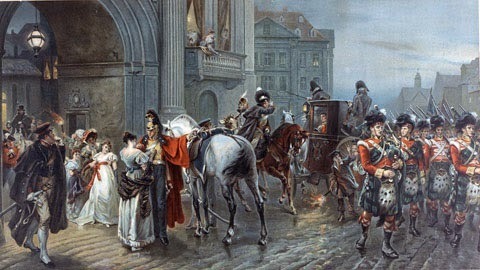 Summoned to Waterloo by R.A. Hillingford
Summoned to Waterloo by R.A. HillingfordWe held a Release Party on Facebook, following up our Cover Reveal party also on FB a couple of weeks ago. It was lots of fun, with almost 200 people posting about what they were wearing, their escorts, doing their own promotion, greeting old and making new friends...and answering lots of questions. Our guest authors are a very impressive group of regency specialists, all of whom offered prizes for responders to their questions,some of which had specific answers and others which solicited opinions and favorites.. They all entered into the fantasy of the event.
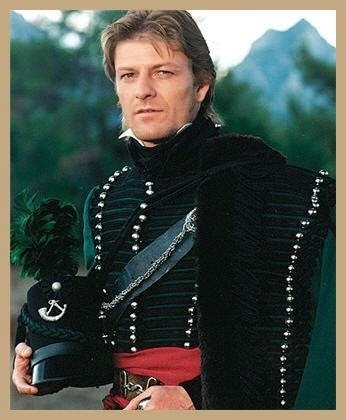
Eileen Dreyer arrived with her escort, Colonel Sharpe, leaving us all swooning. And she modeled her lovely gown.
Sheri Cobb South asked a tricky questions about the Bow Street Runners, but many of us were more diverted by her escort, the esteemed Horatio Hornblower as portrayed by Ioan Gruffudd.
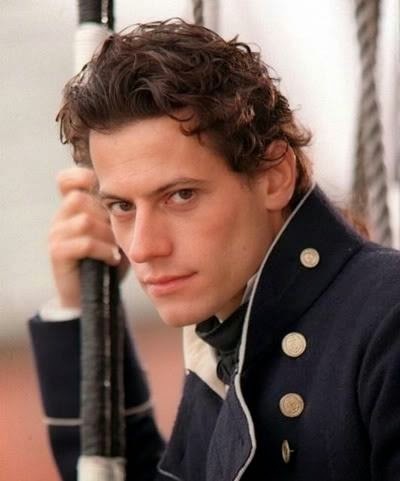
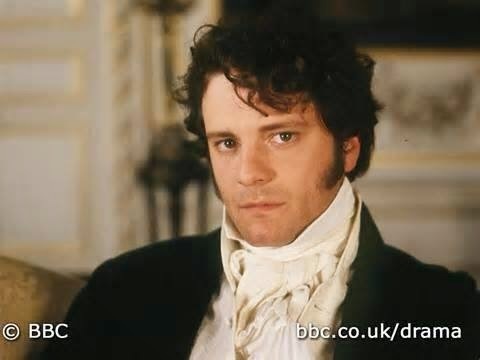
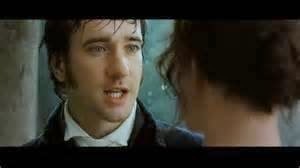
Jessica Jefferson asked which Darcy is your favorite? Mine is Colin Firth. If only Matthew had combed his hair ONCE!
Collette Cameron had a quirky take on castles, including this one of white chocolate! Yum!!
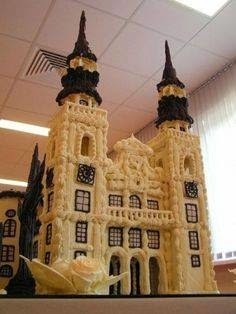
Bronwen Evans responded with picture of New Zealand's only castle,
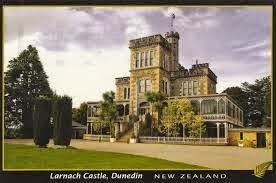
I chose my escort based on his stellar appearance at Horse Guards, a member of the Blues and Royals. We had a wonderful time together!
 On duty at Horse Guards
On duty at Horse GuardsAnnie Burrows showed us pictures of the military unit imagined by a group of Harlequin authors who've done a trilogy on the rouges and their Waterloo brides.
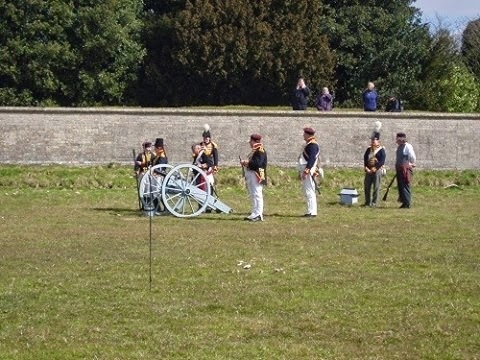 Re-enactors re-imagined
Re-enactors re-imagined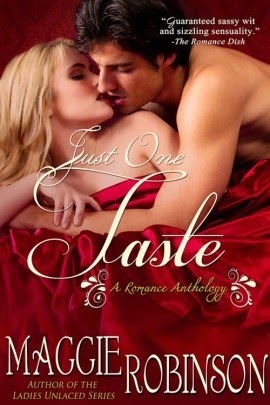
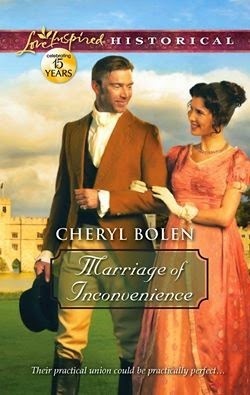
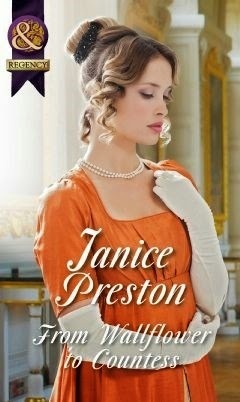
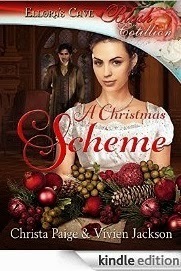
Popular and prolific author Cheryl Bolen sought opinions on whether readers prefer Alpha or Beta heroes. Results were decidedly mixed, with may saying they like the Alpha heroes in fiction, but prefer their Betas in real life. Yep.
Janice Preston asked which three qualities best describe a regency hero.
Vivien Jackson invited readers to tell us how they were originally hooked by Regencies stories.
Maggie Robinson wrote about The British Army's Redcoats and asked about favorite genres to read.
Here is a hint about my story in Beaux, Ballrooms, and Battles: A Celebration of Waterloo, called "Folie Bleue:"
On the night of the 30th Anniversary of the Battle of Waterloo, Aimée, Lady Prescott, reminisces about meeting her husband in Bruxelles on the eve of the fighting. She had avoided the dashing scarlet-clad British officers, but she could not resist the tempting smile and spellbinding charm of Captain Robert Prescott of the 16th Light Dragoons who— dangerously to Aimée— wore blue.
 The Waterloo Banquet by artist William Salter hangs in Apsley House
The Waterloo Banquet by artist William Salter hangs in Apsley HouseThe inspiration for my story came from standing in Apsley House last summer and looking at the painting above -- and wondering who the lonely wives of all the heroes were -- and what they did on the evening of the anniversary of the battle, June 18, when the Duke of Wellington hosted his annual reunion.
Diane Gaston, another of our wonderful guest authors at the Release party, was standing right beside me in Apsley House. Diane posted a picture of the battleground, and talked of the effects of the conflict.
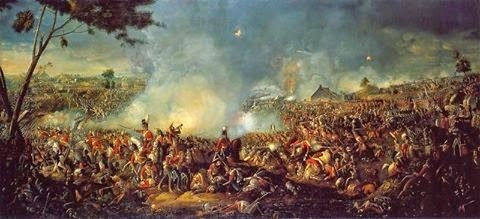 Diane Gaston's posted picture shows the dreadful confusion and carnage of the battle.
Diane Gaston's posted picture shows the dreadful confusion and carnage of the battle.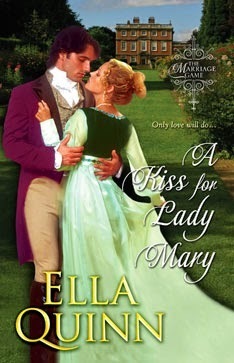
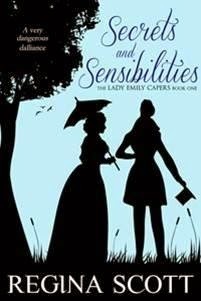
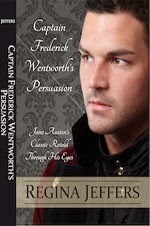
Regina Scott enquired about what kind of pictures you like on your walls...
Regina Jeffers wanted to know if readers think villains possess redeeming qualities.
Ella Quinn indulged in the conversation and perhaps one of the delicious glasses of champagne?
The prize for one of the commenters on my posts was a copy of my first Regency, The Fontainebleau Fan. And the winner was Denise Duvall who wants to see Hever Castle, Hsmpton Court, the Victoria and Albert Museum, and Stirling, Scotland, where she has relatives.Thanks for coming to the party, Denise and watch the snail mail for that book soon!
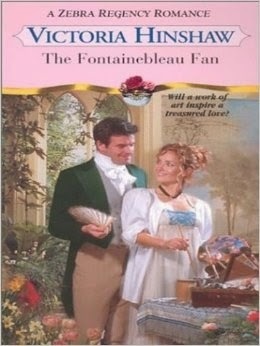
Because all the listings about the Anthology's nine authors are in alphabetical order, I am reversing the trend.
David William Wilkin is not only an excellent writer, but also a tech wizard, who uploaded the versions of the book to various sites....
Sophia Strathmore asked a question similar to mine -- what is your favorite spot to visit or to dream about visiting in England? Christa Paige wanted to know what is the most typical drink you see in Regencies.
Heather King, a horse lover and our UK rep, wrote about the Duke of Wellington's mount, Copenhagen. Last September at the Duke's country home Stratfield Saye, we left roses on the stallion's grave.

Victoria Hinshaw (me!) I was very pleased to be included and I admire all my colleagues as we nine cooks managed not to spoil our broth. I asked what place in England you most wanted to visit.
Aileen Fish masterminded our cover design.
Susana Ellis and Aileen made the Cover Reveal and Release parties happen.
Tea Cooper brought us the Australian point of view and even discovered some interesting connections to Waterloo in her home country.
Jillian Chantal had a difficult question -- How many horses were shot from beneath French Marshal Ney? if you don't know, you better study up!
The Release Party was great fun -- and just for good measure, here's one more suggestion to order your copy at $.99 for a limited time.

Published on April 06, 2015 00:00
April 3, 2015
LOOSE IN LONDON; VISITING SIR JOHN SOANE'S MUSEUM
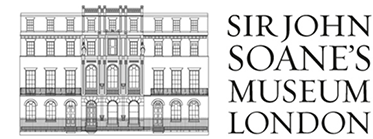
Victoria here. reporting on our visit to Sir John Soane's Museum in Lincoln's Inn Fields.
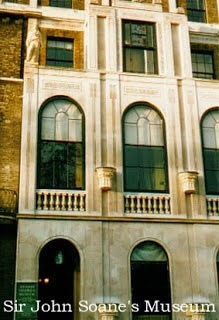
Sir John Soane's Museum has been the topic of several previous posts on this blog. Click here for reprise of my earlier visits.
The museum's website is here. You can read about the many events scheduled even in the midst of an ambitious £7 million program to restore, refurbish, and improve the museum.

The above print shows the three buildings Sir John Soane built at #s 12, 13, and 14 Lincoln's Inn Fields. The Museum,formerly in 12 and 13, purchased #14 and is consolidating offices, enhancing exhibition space and the library and returning the living quarters and teaching rooms to their appearance when Sir John died in 1837. All this is being accomplished while keeping the museum open to the public. As he decreed in his will, it is free -- although please consider a contribution to help ensure its future.
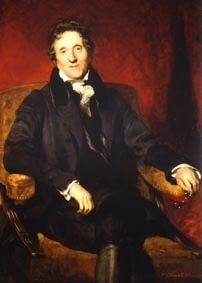 Sir John Soane by Sir Thomas Lawrence
Sir John Soane by Sir Thomas LawrenceSoane (1753-1837) was a distinguished architect and teacher. Among his many buildings were splendid country houses, remodeling of the Bank of England which sadly has been almost obliterated by subsequent alterations, the Dulwich Picture gallery (click here), and Soane's country home Pitshanger Manor in Ealing (click here). The latter two institutions are easily accessible from Central London, being now in what we would call suburbs. Add in one or both on your next jaunt to London.
We've written about them before (click here), and Guest Blogger Jo Manning detailed renovations plans for Pitshanger here.
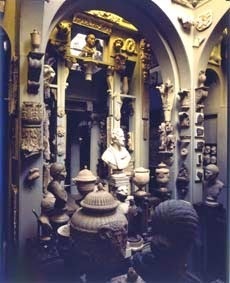 Just a sample of the objects Soane used to instruct his studentsSoane's bust by Sir Francis Chantry in center
Just a sample of the objects Soane used to instruct his studentsSoane's bust by Sir Francis Chantry in centerBut to return to the late summer of 2014, Kristine, Vicky and Marilyn were pleased to poke around among the rooms, some containing scaffolding,and to trot up and down the various back stairs needed while the "front" was being fixed up. From the catacombs to the attics, Sir John filled his abode with instructional materials, aside from a few rooms in which his family lived and entertained.
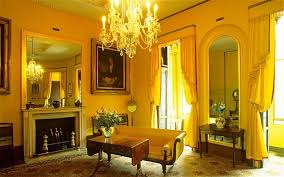 #13 Lincoln's Inn Fields, Sir John Soane's Drawing Room
#13 Lincoln's Inn Fields, Sir John Soane's Drawing RoomWe were there to visit -- or re-visit -- the house as well as experience the small exhibition mounted in 2014 to show a bit of what happened in both Great Britain and France when Napoleon was first expelled and peace established. It is hard of course, to ignore the hindsight we all have, knowing how short that peace lasted, and what the ultimate outcome was by late June of 1815.
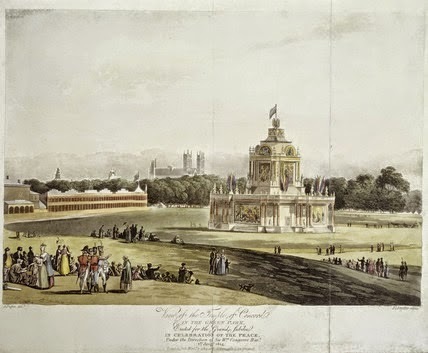 Temple of Concord, 1814, St. James's Park
Temple of Concord, 1814, St. James's ParkWe wrote about this exhibition before we left for London (click here) and we were not the slightest disappointed at what we saw there.
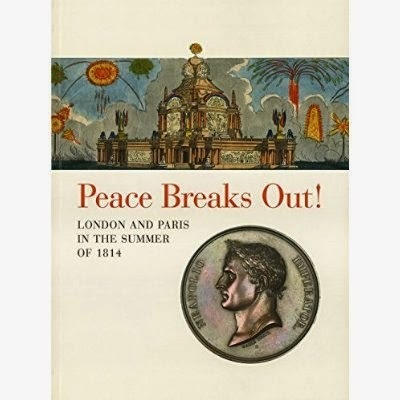 Catalogue
CatalogueThe Catalogue of the Exhibition is available on the website, along with may other wonderful books and objects in the Gift Shop
Published on April 03, 2015 00:00
April 1, 2015
WATERLOO WEDNESDAY: WATERLOO 200 SITE




At this website, Waterloo 200 (click here), you will find all Waterloo events and information, including lots of pictures of relics of the battle and much much more.
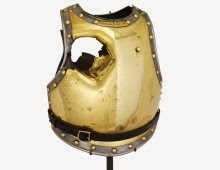
French Army Cuirass, a breastplate worn by the heavy cavalry. This one was pierced by a cannonball, killing Francois-Antoine Fauveau -- or was it his brother? A mystery indeed,
 Waterloo teeth
Waterloo teethAs grisly as it sounds, bodies were mutilated for their teeth, later sold as part of dentures for those who needed them...real teeth, it seems, are far superior to faux ones, but how would you feel if you knew where they came from?
 British cavalry carbine (musket)
British cavalry carbine (musket)Real all about it here.
Take your time exploring this site and you will be multiply rewarded!
Published on April 01, 2015 00:00
March 30, 2015
AN ARTIST OF WATERLOO
Many great artists painted scenes of Waterloo, as based on visits to the battlefield in the wake of the conflict and/or imagined later.
Victoria here, writing of one of my favorites, Robert Alexander Hillingford (1825-1904), born in London He studied in Germany and worked in Italy for several years. After he returned to London in 1864, he began to do historical paintings and became a regular exhibitor at the Royal Academy and other prominent galleries.
His painting of the Duchess of Richmond’s Ball hangs at Goodwood House, the Richmond ducal seat in West Sussex.
 The Duchess Richmond's Ball by Robert A. Hillingford
The Duchess Richmond's Ball by Robert A. Hillingford
Details from the painting are featured on the cover of the Beaux, Ballrooms, and Battles: A Celebration of Waterloo. This anthology brings you nine stories by nine best-selling and award-winning authors, including me (she whispered shamelessly).
An exhibition, Dancing into Battle, on view at Goodwood House August 3 to October 22, 2015, is organized around the famous painting. For the website, click here.From the description of the display:“On 15th June 1815, the Duchess of Richmond hosted a ball at her home in Brussels. ... Goodwood’s summer exhibition will celebrate the 200th anniversary of the ball… “Like many English aristocrats, the 4th Duke and Duchess of Richmond were living in Brussels owing to straightened financial circumstances. Their house became a hub of social activity filled with family and friends, including their own fourteen children. The Duchess invited the cream of Belgian and Dutch society, British civilians, diplomats and army officers to her ball. The Duke of Wellington, a great friend of the family, and the Prince of Orange were among the guests, all of whom appear in her guest list which is one of the treasures of the Goodwood collection – and which will also be on display during the summer exhibition. “... The message that was delivered to Wellington in the middle of the ball reported that Napoleon had crossed the border into Belgium. Examining a map with the Duke of Richmond, Wellington declared, ‘Napoleon has humbugged me, by God, he has gained twenty-four hours march on me’. When Richmond asked what he intended to do, he said that he had told the army to concentrate at Quatre-Bras, but that he would not stop Napoleon there, and pointing to the map placed his thumbnail on Waterloo declaring ‘I must fight him here’. “That night many of the guests left straight for the holding battle of Quatre-Bas, followed two days later by the battle of Waterloo. Heart-wrenching scenes took place in the early hours of the morning as soldiers said goodbye to their loved ones, some never to see them again."
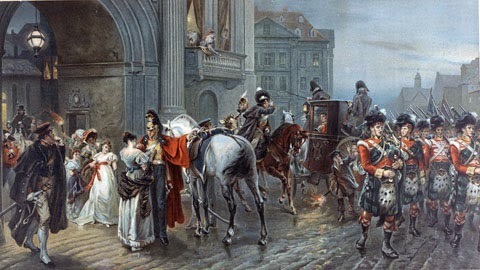 Summoned to Waterloo by Robert A. Hillingford
Summoned to Waterloo by Robert A. Hillingford
Hillingford's painting, Summoned to Waterloo, depicts the courtyard of the house where the ball was held. At dawn on June 16th, the soldiers are leaving their sweethearts to head for combat.
On the site of the Richmond Ball in Brussels an office building now stands; there is no trace left of the dramatic scenes of June 15-16, 1815.
 The Turning Point by Robert A. Hillingford
The Turning Point by Robert A. Hillingford
The Turning Point shows Napoleon and his Imperial Guard at the moment he realizes their attack on Wellington’s troops is failing.
 Lord Hill Inviting Surrender of the Imperial Guard by Robert A. Hillingford
Lord Hill Inviting Surrender of the Imperial Guard by Robert A. Hillingford
Another Waterloo painting by Hillingford shows General Rowland Hill, 1st Viscount Hill, commander of the British II Corps, inviting the French Imperial Guard to surrender at the end of the battle late in the day.
 Wellington At Waterloo by Robert A. Hillingford
Wellington At Waterloo by Robert A. Hillingford
Most famous of all, perhaps, is Hillingford’s portrayal of the Duke of Wellington mounted on Copenhagen, summoning his troops to the final attack. “Up Guards and at them again,” he called, according to a Captain of the Foot Guards.
Hillingford completed many detailed battle scenes, from several wars. Though completed long after the battles themselves, they convey both vivid action and spectacle.
 English Civil War Scene (between 1642-1649)by Robert A Hillingford
English Civil War Scene (between 1642-1649)by Robert A Hillingford
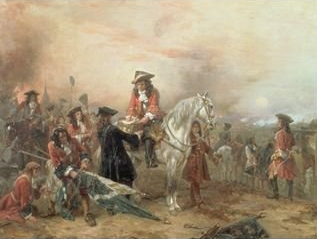 Marlborough Signing the Blenheim Dispatch in 1794 by Robert Alexander Hillingford.
Marlborough Signing the Blenheim Dispatch in 1794 by Robert Alexander Hillingford.
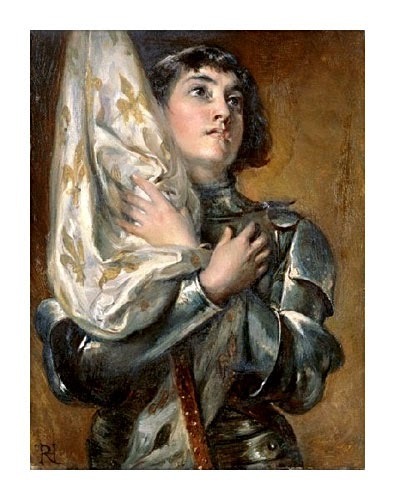 Saint Joan d'Arc by Robert A. Hillingford
Saint Joan d'Arc by Robert A. Hillingford
This portrait is much more intimate and conveys the spirit of Joan (c.1412-1431), if not her precise appearance.
 Peasants of the Campagna by Robert A. Hilllingford
Peasants of the Campagna by Robert A. Hilllingford
He painted a wide variety of popular scenes, including some on which he drew from his experiences in Italy.
And he did many scenes from the theatre, such as the one below.
 Much Ado About Nothing by Robert A. Hillingford
Much Ado About Nothing by Robert A. Hillingford
Victoria here, writing of one of my favorites, Robert Alexander Hillingford (1825-1904), born in London He studied in Germany and worked in Italy for several years. After he returned to London in 1864, he began to do historical paintings and became a regular exhibitor at the Royal Academy and other prominent galleries.
His painting of the Duchess of Richmond’s Ball hangs at Goodwood House, the Richmond ducal seat in West Sussex.
 The Duchess Richmond's Ball by Robert A. Hillingford
The Duchess Richmond's Ball by Robert A. HillingfordDetails from the painting are featured on the cover of the Beaux, Ballrooms, and Battles: A Celebration of Waterloo. This anthology brings you nine stories by nine best-selling and award-winning authors, including me (she whispered shamelessly).

An exhibition, Dancing into Battle, on view at Goodwood House August 3 to October 22, 2015, is organized around the famous painting. For the website, click here.From the description of the display:“On 15th June 1815, the Duchess of Richmond hosted a ball at her home in Brussels. ... Goodwood’s summer exhibition will celebrate the 200th anniversary of the ball… “Like many English aristocrats, the 4th Duke and Duchess of Richmond were living in Brussels owing to straightened financial circumstances. Their house became a hub of social activity filled with family and friends, including their own fourteen children. The Duchess invited the cream of Belgian and Dutch society, British civilians, diplomats and army officers to her ball. The Duke of Wellington, a great friend of the family, and the Prince of Orange were among the guests, all of whom appear in her guest list which is one of the treasures of the Goodwood collection – and which will also be on display during the summer exhibition. “... The message that was delivered to Wellington in the middle of the ball reported that Napoleon had crossed the border into Belgium. Examining a map with the Duke of Richmond, Wellington declared, ‘Napoleon has humbugged me, by God, he has gained twenty-four hours march on me’. When Richmond asked what he intended to do, he said that he had told the army to concentrate at Quatre-Bras, but that he would not stop Napoleon there, and pointing to the map placed his thumbnail on Waterloo declaring ‘I must fight him here’. “That night many of the guests left straight for the holding battle of Quatre-Bas, followed two days later by the battle of Waterloo. Heart-wrenching scenes took place in the early hours of the morning as soldiers said goodbye to their loved ones, some never to see them again."
 Summoned to Waterloo by Robert A. Hillingford
Summoned to Waterloo by Robert A. HillingfordHillingford's painting, Summoned to Waterloo, depicts the courtyard of the house where the ball was held. At dawn on June 16th, the soldiers are leaving their sweethearts to head for combat.
On the site of the Richmond Ball in Brussels an office building now stands; there is no trace left of the dramatic scenes of June 15-16, 1815.
 The Turning Point by Robert A. Hillingford
The Turning Point by Robert A. HillingfordThe Turning Point shows Napoleon and his Imperial Guard at the moment he realizes their attack on Wellington’s troops is failing.
 Lord Hill Inviting Surrender of the Imperial Guard by Robert A. Hillingford
Lord Hill Inviting Surrender of the Imperial Guard by Robert A. HillingfordAnother Waterloo painting by Hillingford shows General Rowland Hill, 1st Viscount Hill, commander of the British II Corps, inviting the French Imperial Guard to surrender at the end of the battle late in the day.
 Wellington At Waterloo by Robert A. Hillingford
Wellington At Waterloo by Robert A. HillingfordMost famous of all, perhaps, is Hillingford’s portrayal of the Duke of Wellington mounted on Copenhagen, summoning his troops to the final attack. “Up Guards and at them again,” he called, according to a Captain of the Foot Guards.
Hillingford completed many detailed battle scenes, from several wars. Though completed long after the battles themselves, they convey both vivid action and spectacle.
 English Civil War Scene (between 1642-1649)by Robert A Hillingford
English Civil War Scene (between 1642-1649)by Robert A Hillingford Marlborough Signing the Blenheim Dispatch in 1794 by Robert Alexander Hillingford.
Marlborough Signing the Blenheim Dispatch in 1794 by Robert Alexander Hillingford. Saint Joan d'Arc by Robert A. Hillingford
Saint Joan d'Arc by Robert A. HillingfordThis portrait is much more intimate and conveys the spirit of Joan (c.1412-1431), if not her precise appearance.
 Peasants of the Campagna by Robert A. Hilllingford
Peasants of the Campagna by Robert A. HilllingfordHe painted a wide variety of popular scenes, including some on which he drew from his experiences in Italy.
And he did many scenes from the theatre, such as the one below.
 Much Ado About Nothing by Robert A. Hillingford
Much Ado About Nothing by Robert A. Hillingford
Published on March 30, 2015 00:30
March 27, 2015
LOOSE IN LONDON: THE TALE OF THE SHOES
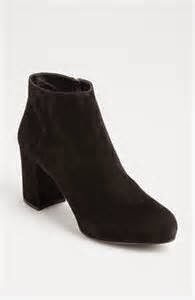
So, the tale of Kristine's shoes continues. If you thought, because my feet hadn't been mentioned in the last few posts, that the problem had resolved itself, not so. I was still in pain, still bandaging my feet every morning and every eve. When last we left you, we had all been reunited with Victoria in the tea tent behind Buckingham Palace. Whilst I was glad to be reunited with Victoria, I was having a hard time keeping the grimace off my face. I had that morning decided to wear a shorter pair of black boots for our Royal Day Out, and they worked out fine - until the late afternoon, when they began to attack all the spots on my feet that hadn't been torn to shreds previously. By the end of our day, I was in real pain.

I must say that the Royals have really got the tourist dollar thing down to a science. When you end the tour of Buckingham Palace, they see that you exit at the tea tent, which leads down a lane to a huge gift shop, which then exits you onto a path through the royal gardens behind the Palace. All of which would have been a delight if every single step wasn't outright torture.

You've no idea how happy I was when we made a pit stop at the Bag O' Nails in Buckingham Palace Road for a much needed drink.
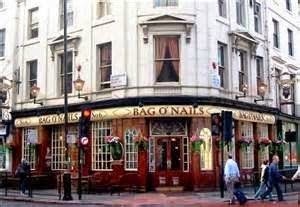
Now, I'm skipping ahead a bit here in order to tie up the tale of the shoes and for all of us to be done with the state of my feet. If you recall, our Royal Day Out took place on the Sunday, so all shops were shut. No hope of buying an alternate, comfortable pair of shoes. Next day, Victoria, Marilyn and I visited the Soane Museum, Covent Garden, the Duke of Wellington Pub and Cecil Court, amongst other places. I promise that we'll be covering all that in full in the near future. For now, know that at the end of that day, I made a pit stop at the Peter Jones department store in Sloane Square, just doors away from our hotel.
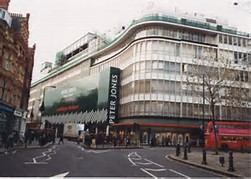
I was after a pair of flip flops. I'd go so far as to say that at that moment, I lusted after a pair of flip flops. Which was pretty funny actually, as I live in Florida and own numerous pairs of flip flops. In fact, as I'd been packing for this trip, a little voice in my head had encouraged me to throw a pair of flip flops into my suitcase. Don't be daft, I'd told myself, what are you going to do with flip flops in England? Throw in another pair of boots instead. Oy vey.
But I digress (again). I took the escalator up to the shoe department only to find that the selection of summer shoes was slim, indeed. Finally, I found a too large pair of plain flip flops and grabbed at them as if they were pure gold. Eureka!
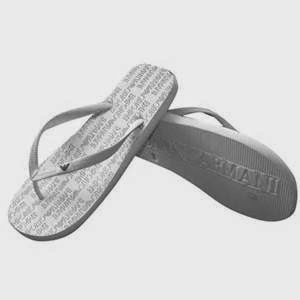
Now, these are not the exact pair I bought, but they're close enough. Just a plain old pair of flip flops, the sort you can buy at any store in Florida for $7.99. These cost me twenty pounds - or roughly $35.00. A crime, really, but well worth the price for comfort alone.
I'd like to be able to tell you that the Tale of the Shoes ended there, but it didn't. A few days on, when the Duke of Wellington Tour actually started, we visited Apsley House. I'd been wearing my flip flops every day since I'd bought them, but really, one can't wear flip flops to Apsley House. It just wasn't done, or so I thought. So I put my short, black boots on for our private tour of the house. Again, Victoria and I will be covering our visit to Apsley House and the Wellington Arch shortly, but for now you should know that I did pretty well with the boots on until we got to the striped drawing room just beyond the dining room. My feet began to yell in protest and I made a beeline to the settee you can see in the photo below.

You may recall that this is the same settee that Hubby and I had sat upon together during a previous trip when we paused to admire the Thomas Lawrence portrait of the Duke below.

Upon leaving Apsley House, we were scheduled for a private guided tour of the Wellington Arch.

We made our way through the pedestrian underpass to the Arch, when I finally took my boots off and walked the rest of the way barefoot. I hoped that the Duke wouldn't perceive this as a mark of disrespect but, knowing how he felt about his soldiers being well shod, I took the chance that he'd appreciate my predicament.

Across the lawn I walked, barefoot, heedless of what, exactly, I was stepping upon.

Once inside the Arch, we climbed, and climbed, and climbed to the top. Reader, I would never had made it had I still been wearing my boots.

At the top, we had a true bird's eye view of the Guards as they made their way back to the barracks from the Palace. All went well until we reached the ground again and I discovered that the Guards, or rather their horses, had left me a few things to be avoided, especially whilst barefooted.


Back across the grass I walked until we'd reached our tour bus, where I put my flip flops back on and left them on for the remainder of the trip. And that, dear Readers, ends the tale of my feet. And shoes. Your sympathy has been much appreciated.
More Loose In London coming soon!
Published on March 27, 2015 00:30
Kristine Hughes's Blog
- Kristine Hughes's profile
- 6 followers
Kristine Hughes isn't a Goodreads Author
(yet),
but they
do have a blog,
so here are some recent posts imported from
their feed.



